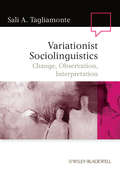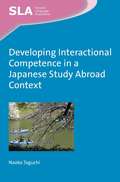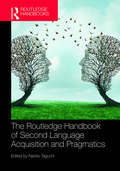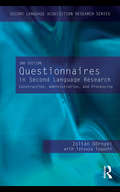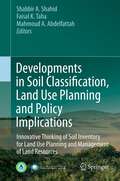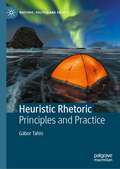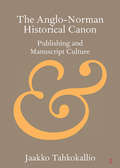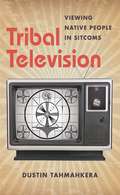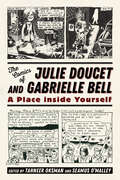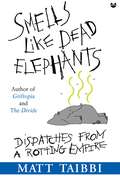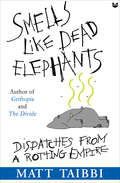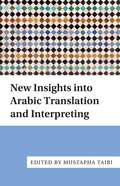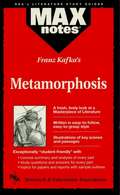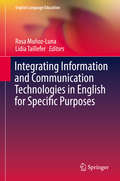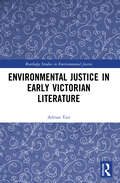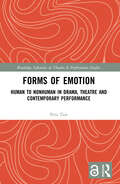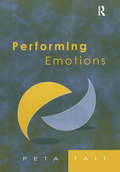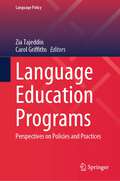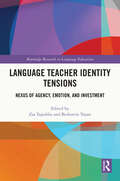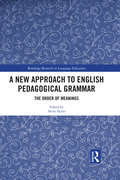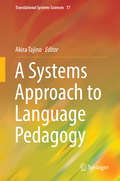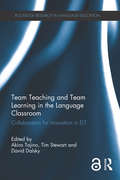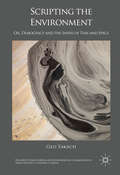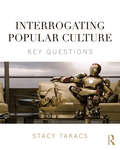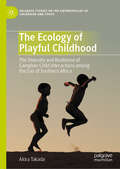- Table View
- List View
Variationist Sociolinguistics: Change, Observation, Interpretation (Language in Society #39)
by Sali A. TagliamonteVariationist Sociolinguistics: Change, Observation, Interpretation presents a comprehensive, intermediate level examination of Language Variation and Change, the branch of sociolinguistics concerned with linguistic variation in spoken and written language. Represents the most up-to-date coverage of the history, developments, and methodologies of variationist sociolinguistics Addresses all aspects of linguistic variation, including areas not usually covered in introductory texts, e.g. the phonological, morpho-syntactic, discourse/pragmatic Outlines comparative sociolinguistic approach, data collection, methodological issues; and addresses state-of-the-art contemporary quantitative methods and statistical practice Features cutting-edge research at an appropriate level to facilitate student learning Engages students throughout with a variety of pedagogical features, including Mini Quizzes to test comprehension, extensive Exercises at the end of each chapter, the opportunity to do hands-on quantitative analysis of a never-before published data set, and Notes and Tips that offer insight into conducting sociolinguistic research. Extra materials and answers to the exercises are available at www.wiley.com/go/tagliamonte
Developing Interactional Competence in a Japanese Study Abroad Context
by Naoko TaguchiIn the process of second language acquisition, the ability to interact effectively is critical. But what does it mean to be interactively competent? This book addresses this question by presenting research on the development of interactional competence among learners of Japanese as a second language. Qualitative data collected on learners studying abroad in Japan is evaluated to explain changes in their interactional competence and provides specific insights into the learning of Japanese. The situated analysis of multiple data sets generates meaningful interpretations of the development of interactional competence in the development of interactional competence and the learner-specific factors that shape developmental trajectories. Moreover, the context of the research provides insights into the types of learning resources and experiences that study abroad provides to assist learners' in their progress towards becoming a competent speaker in the target community.
The Routledge Handbook of Second Language Acquisition and Pragmatics (The Routledge Handbooks in Second Language Acquisition)
by Naoko TaguchiThe Routledge Handbook of Second Language Acquisition and Pragmatics is a comprehensive critical survey of the field of L2 pragmatics, collecting a number of chapters that highlight the key theories, methods, pedagogies, and research findings throughout its development over the last four decades. Demonstrating the ways in which pragmatics has long served as a lens through which to examine patterns of L2 development, the volume is divided into six parts which reflect the field’s structure and evolution: • Constructs and units of analysis • Theoretical approaches • Methodological approaches • Pedagogical approaches • Contexts and individual considerations • L2 pragmatics in the global era The handbook has a particular focus on covering not only traditional topics in the field, such as constructs of pragmatic competence (e.g., speech acts, implicature), teaching and assessment, and pragmatics learning in a study abroad program, but also emerging areas of study, including interactional pragmatics, intercultural pragmatics, usage-based approaches, corpus linguistics, and psycholinguistic experimentation. Each chapter introduces the topic and follows with a description of its theoretical underpinnings, an overview of existing literature, appraisal of current practice, concluding with a discussion of future directions for research and key readings. The Routledge Handbook of Second Language Acquisition and Pragmatics is an essential resource for those with an interest in second language acquisition, pragmatics, and language teaching.
Questionnaires in Second Language Research: Construction, Administration, and Processing (2nd Edition)
by Tatsuya Taguchi Zoltán DörnyeiQuestionnaires in Second Language Research: Construction, Administration, and Processing is the first guide in the second language field devoted to the question of how to produce and use questionnaires as reliable and valid research instruments. It offers a thorough overview of the theory of questionnaire design, administration, and processing, made accessible by concrete, real-life second language research applications. This Second Edition features a new chapter on how an actual scientific instrument was developed using the theoretical guidelines in the book, and new sections on translating questionnaires and collecting survey data on the Internet. Researchers and students in second language studies, applied linguistics, and TESOL programs will find this book invaluable, and it can also be used as a textbook for courses in quantitative research methodology and survey research in linguistics, psychology, and education departments.
Developments in Soil Classification, Land Use Planning and Policy Implications
by Faisal K. Taha Mahmoud A. Abdelfattah Shabbir A. ShahidAs the world's population continues to expand, maintaining and indeed increasing agricultural productivity is more important than ever, though it is also more difficult than ever in the face of changing weather patterns that in some cases are leading to aridity and desertification. The absence of scientific soil inventories, especially in arid areas, leads to mistaken decisions about soil use that, in the end, reduce a region's capacity to feed its population, or to guarantee a clean water supply. Greater efficiency in soil use is possible when these resources are properly classified using international standards. Focusing on arid regions, this volume details soil classification from many countries. It is only once this information is properly assimilated by policymakers it becomes a foundation for informed decisions in land use planning for rational and sustainable uses.
Heuristic Rhetoric: Principles and Practice (Rhetoric, Politics and Society)
by Gábor TahinThis book introduces a novel approach to the analysis and practice of persuasive speaking and writing: heuristic rhetoric. The new method has evolved to fulfil the need at universities, government departments, political organisations, business enterprises and other public institutions for a modern practical alternative to classical rhetoric, which is, in the author’s view, no longer capable of giving a complete description of contemporary, predominantly mediatised, forms of public persuasive discourse, whilst other competing disciplines, such as critical discourse analysis or strategic manoeuvring, have not yet produced a set of tools, which have the comprehensive nature and practical orientation of Classical Greek and Roman rhetorical system. The book expounds heuristic rhetoric as an inter-disciplinary method to develop advanced skills of critical and strategic reasoning. Applying a novel set of principles for the strategic analysis of persuasive reasoning in complex rhetorical situations, the method emphasizes preparing and continuously adjusting argumentation according to the demands of unpredictable circumstances.
The Anglo-Norman Historical Canon: Publishing and Manuscript Culture (Elements in Publishing and Book Culture)
by Jaakko TahkokallioThis Element is a contribution to the ongoing debate on what it meant to publish a book in manuscript. It offers case-studies of three twelfth-century Anglo-Norman historians: William of Malmesbury, Henry of Huntingdon, and Geoffrey of Monmouth. It argues that the contemporary success and rapid attainment of canonical authority for their histories was in significant measure the result of successfully conducted publishing activities. These activities are analysed using the concept of a 'publishing circle'. This concept, it is suggested, may have wider utility in the study of authorial publishing in a manuscript culture. This Element is also available as Open Access.
Tribal Television
by Dustin TahmahkeraNative Americans have been a constant fixture on television, from the dawn of broadcasting, when the iconic Indian head test pattern was frequently used during station sign-ons and sign-offs, to the present. In this first comprehensive history of indigenous people in television sitcoms, Dustin Tahmahkera examines the way Native people have been represented in the genre. Analyzing dozens of television comedies from the United States and Canada, Tahmahkera questions assumptions that Native representations on TV are inherently stereotypical and escapist. From The Andy Griffith Show and F-Troop to The Brady Bunch, King of the Hill, and the Native-produced sitcom, Mixed Blessings, Tahmahkera argues that sitcoms not only represent Native people as objects of humor but also provide a forum for social and political commentary on indigenous-settler relations and competing visions of America. Considering indigenous people as actors, producers, and viewers of sitcoms as well as subjects of comedic portrayals, Tribal Television underscores the complexity of Indian representations, showing that sitcoms are critical contributors to the formation of contemporary indigenous identities and relationships between Native and non-Native people.
The Comics of Julie Doucet and Gabrielle Bell: A Place inside Yourself (Critical Approaches to Comics Artists Series)
by Tahneer Oksman and Seamus O’MalleyWinner of the 2020 Comics Studies Society Edited Book PrizeContributions by Kylie Cardell, Aaron Cometbus, Margaret Galvan, Sarah Hildebrand, Frederik Byrn Køhlert, Tahneer Oksman, Seamus O’Malley, Annie Mok, Dan Nadel, Natalie Pendergast, Sarah Richardson, Jessica Stark, and James Yeh In a self-reflexive way, Julie Doucet’s and Gabrielle Bell’s comics, though often autobiographical, defy easy categorization. In this volume, editors Tahneer Oksman and Seamus O’Malley regard Doucet’s and Bell’s art as actively feminist, not only because they offer women’s perspectives, but because they do so by provocatively bringing up the complicated, multivalent frameworks of such engagements. While each artist has a unique perspective, style, and worldview, the essays in this book investigate their shared investments in formal innovation and experimentation, and in playing with questions of the autobiographical, the fantastic, and the spaces in between. Doucet is a Canadian underground cartoonist, known for her autobiographical works such as Dirty Plotte and My New York Diary. Meanwhile, Bell is a British American cartoonist best known for her intensely introspective semiautobiographical comics and graphic memoirs, such as the Lucky series and Cecil and Jordan in New York. By pairing Doucet alongside Bell, the book recognizes the significance of female networks, and the social and cultural connections, associations, and conditions that shape every work of art. In addition to original essays, this volume republishes interviews with the artists. By reading Doucet’s and Bell’s comics together in this volume housed in a series devoted to single-creator studies, the book shows how, despite the importance of finding “a place inside yourself” to create, this space seems always for better or worse a shared space culled from and subject to surrounding lives, experiences, and subjectivities.
Smells like Dead Elephants: Dispatches from a Rotting Empire
by Matt TaibbiMatt Taibbi is notorious as a journalistic agitator, a stone thrower, a "natural provocateur" (Salon. com). His scathing, vibrant prose shines an unflinching spotlight on the corruption, dishonesty, and sheer laziness of our leaders. Smells Like Dead Elephants brings together Taibbi's most incisive, intense, and hilarious work from his "Road Work" column in Rolling Stone. Written over the last two years, a period in our history with no shortage of outrages to compel Taibbi's pen, these pieces paint a shocking portrait of our government at work--or, as Taibbi points out in "The Worst Congress Ever," rarely working. "In the Sixties and Seventies, Congress met an average of 162 days a year. The 109th Congress set the all-time record for fewest days worked by a U.S. Congress: 93. Figuring for half-days, in fact, the 109th Congress probably worked almost two months less than the notorious 'Do-Nothing' Congress of 1948". Taibbi has plenty to say about George W. Bush, Jack Abramoff, Tom DeLay, and all the rest, but he doesn't just hit inside the Beltway. He gets involved in the action, infiltrating Senator Conrad Burns's birthday party under disguise as a lobbyist for a fictional oil firm that wants to drill in the Grand Canyon. He floats into apocalyptic post-Katrina New Orleans in a dinghy with Sean Penn. He goes to Iraq as an embedded reporter, where he witnesses the mind-boggling dysfunction of our occupation and spends three nights in Abu Ghraib prison. And he reports from two of the most bizarre and telling trials in recent memory: California v. Michael Jackson and the evolution-vs.-intelligent-design trial in Harrisburg, Pennsylvania. A brilliant collection from one of the most entertaining political writers of today, Smells Like Dead Elephants is a stylish record of the offenses of the Bush years.
Smells Like Dead Elephants: Dispatches from a Rotting Empire
by Matt TaibbiSmells Like Dead Elephants is a brilliant collection from Matt Taibbi, a political reporter with the gonzo spirit that made Hunter S. Thompson and P. J. O’Rourke so much fun” (The Washington Post). Bringing together Taibbi’s most incisive and hilarious work from his Road Work” column in Rolling Stone, Smells Like Dead Elephants shines an unflinching spotlight on the corruption, dishonesty, and sheer laziness of our leaders. Taibbi has plenty to say about George W. Bush, Jack Abramoff, Tom DeLay, and all the rest, but he doesn’t just hit inside the Beltway. He gets involved in the action, infiltrating Senator Conrad Burns’s birthday party under disguise as a lobbyist for a fictional oil firm that wants to drill in the Grand Canyon. He floats into apocalyptic post-Katrina New Orleans in a dinghy with Sean Penn. He goes to Iraq as an embedded reporter, where he witnesses the mind-boggling dysfunction of our occupation and spends three nights in Abu Ghraib prison. And he reports from two of the most bizarre and telling trials in recent memory: California v. Michael Jackson and the evolution-vs.-intelligent-design trial in Harrisburg, Pennsylvania. Equally funny and shocking, this is excellent work from one of our most entertaining writers.
New Insights into Arabic Translation and Interpreting
by Mustapha TaibiThis book addresses translation and interpreting with Arabic either as a source or target language. It focuses on new fields of study and professional practice, such as community translation and interpreting, and offers fresh insights into the relationship between culture, translation and interpreting. Chapters discuss issues relating specifically to Arabic and the Arab cultural context and contribute views, research findings and applications that come from a language combination and a cultural background quite different from traditional Eurocentric theoretical and professional positions. This volume is a significant addition to resources on Arabic translation and interpreting and contributes fresh perspectives to translation studies in general. It is of interest to students, researchers and professionals working in public service, community, legal, administrative and healthcare translation and interpreting, as well as intercultural communication and translator education.
Metamorphosis (MAXNotes Literature Guides)
by Stanley TaikeffMAXnotes offer a fresh look at masterpieces of literature, presented in a lively and interesting fashion. Written by literary experts who currently teach the subject, MAXnotes will enhance your understanding and enjoyment of the work. MAXnotes are designed to stimulate independent thought about the literary work by raising various issues and thought-provoking ideas and questions. MAXnotes cover the essentials of what one should know about each work, including an overall summary, character lists, an explanation and discussion of the plot, the work's historical context, illustrations to convey the mood of the work, and a biography of the author. Each chapter is individually summarized and analyzed, and has study questions and answers.
Integrating Information and Communication Technologies in English for Specific Purposes (English Language Education #10)
by Lidia Taillefer Rosa Muñoz-LunaThis book fills the need for a text that integrates Information and Communication Technologies (ICTs) into English for Specific Purposes (ESP). It offers insights on current methodological principles in ESP in both academic and professional contexts, drawing on authentic teaching and learning situations, and analyses best practice guidelines. Part I begins with ESP pedagogical principles and technological practice in order to focus on its two main branches: English for Academic Purposes, which includes linguistic skills and students’ needs, and English for Occupational Purposes, specifically looking at Business, Medical and Translators courses. This book is a great resource for ESP researchers, educators and students, because it provides case studies of how ICTs can be used in English for multiple purposes. Authors present their experiences of integrating tools into their instructions, with each chapter contributing unique pedagogical implications.
Environmental Justice in Early Victorian Literature (Routledge Studies in Environmental Justice)
by Adrian TaitThis innovative new book combines environmental justice scholarship with a material ecocriticism to explore the way in which early Victorian literature (1837–1860) responded to the growing problem of environmental injustice. As this book emphasises, environmental injustice – simply, the convergence of poverty and pollution – was not an isolated phenomenon, but a structural form of inequality; a product of industrial modernity’s radical reformation of British society, it particularly affected the working classes. As each chapter reveals in detail, this form of environmental inequality (or ‘classism’) drew sharply critical reactions from figures as diverse as Thomas Carlyle, Friedrich Engels, Charles Dickens, and John Ruskin, and from within the Chartist movement, as working-class writers themselves reacted to the hazardous realities of a divided society. But as this book also reveals, these writers recognised that a truly just society respects the needs of the nonhuman and takes account of the material world in all its own aliveness; even if only tentatively, they reached for a more inclusive, emergent form of justice that might address the social and ecological impacts of industrial modernity, an idea which is no less relevant today. This book represents an indispensable resource for scholars and students working in the fields of Victorian literature, environmental justice, and ecocriticism.
Forms of Emotion: Human to Nonhuman in Drama, Theatre and Contemporary Performance (Routledge Advances in Theatre & Performance Studies)
by Peta TaitForms of Emotion analyses how drama, theatre and contemporary performance present emotion and its human and nonhuman diversity. This book explores the emotions, emotional feelings, mood, and affect, which make up a spectrum of ‘emotion’, to illuminate theatrical knowledge and practice and reflect the distinctions and debates in philosophy, neuroscience, psychology, and other disciplines. This study asserts that specific forms of emotion are intentionally unified in drama, theatre, and performance to convey meaning, counteract separation and subversively champion emotional freedom. The book progressively shows that the dramatic and theatrical representation of the nonhuman reveals how human dominance is offset by emotional connection with birds, animals, and the natural environment. This book will be of great interest to students and researchers interested in the emotions and affect in dramatic literature, theatre studies, performance studies, psychology, and philosophy as well as artists working with emotionally expressive performance.
Performing Emotions: Gender, Bodies, Spaces, in Chekhov's Drama and Stanislavski's Theatre
by Peta TaitIn Performing Emotions, Peta Tait's central argument is that performing emotions in realism is also performing gender identity. Emotions are phenomena that are performable by bodies, which have cultural identities. In turn, these create cultural spaces of emotions. This study integrates scholarship on realist drama, theatre and approaches to acting, with interdisciplinary theories of emotion, phenomenology and gender theory. With chapters devoted to masculinity and femininity specifically, as well as to emotions generally, it investigates social beliefs about emotions through Chekhov's four major plays in translation, and English language commentaries on Constantin Stanislavski's direction (of the play's first productions) and his approaches to acting, and Olga Knipper's acting of the central women characters. Emotions exists as social relationships; they are imagined and embodied as gendered. Tait demonstrates how theatrical emotions are predicated on social performances and vice versa. In Chekhov's plays, which came to dominate a twentieth century theatre of emotions, characters interpret their emotions intertextually in relation to other theatrical and fictional narratives of emotions. Tait here interrogates these plays as sustained explorations of the inherent theatricality of characters expressing emotions from their phenomenological awareness. A theatrical language of gendered interiority is produced in the acting of emotions in Stanislavski's early realistic theatre. Alternatively, remapping the performances of emotional bodies can destabilise the culturally constructed boundary separating an inner, private self and an outer, social self in culturally produced geographies of emotions. As Tait shows, emotions can be performed as indivisible spatialities. Performing Emotions integrates theories of theatre, gender identity and emotion to investigate how sexual difference impacts on the representations of emotions. The book develops an accumulative analysis of the meanings of emotions in twentieth century realist drama, theatre and acting.
Language Education Programs: Perspectives on Policies and Practices (Language Policy #34)
by Zia Tajeddin Carol GriffithsThis book delves into the realm of effective language education programs, examining them from both macro and micro-policy-making perspectives. It unravels the distinguishing features of exemplary language programs and explores how these programs are implemented in diverse international contexts. The book comprehensively explores various facets of language education programs, encompassing well-crafted language education policies, robust curriculum and syllabus design, impactful teaching materials, effective approaches to English for specific purposes (ESP), English as a medium of instruction (EMI), content and language integrated learning (CLIL), and English as a Lingua Franca (ELF)-informed instruction. The book also delves into fruitful school/institute-university partnerships, the judicious use of technology, strategies for teacher recruitment and professional development, as well as efficient policies for learner assessment, among other topics of significance. The contributions within this book are firmly grounded in data, incorporating findings from empirical studies. The insights provided draw upon valuable data obtained from a range of diverse contexts in which effective language education programs have been implemented.
Language Teacher Identity Tensions: Nexus of Agency, Emotion, and Investment (Routledge Research in Language Education)
by Zia Tajeddin Bedrettin YazanAddressing the critical issue of teacher identity tensions, this edited volume looks at the tensions between teachers’ instructional beliefs, values, and priorities, and the contextual constraints and requirements. It examines how teachers deal with these tensions to avoid demotivation and burnout, which play a significant role in identity construction. Tensions are inseparable from growth and transformation but have the potential to disrupt teacher identity construction. Therefore, continual efforts to resolve tensions in teaching are inevitable. The process of resolution or reconciliation might be extended, and teachers could need support in that process to minimize the possible negative impacts on their identities. This process can simultaneously generate positive outcomes for teachers’ growth and learning. Therefore, how teachers perceive, respond to, and grapple with tensions are critical experiences that offer windows into the complexities of teacher identity negotiation.The volume paints a picture of the personal, professional, and political dimensions of teacher identity tensions in various international contexts. The chapters draw on empirical studies with clear pedagogical implications to illustrate what identity tensions language teachers face in and outside the classroom during their career trajectory, how language teachers cope with identity tensions in their professional life, and how teacher educators can integrate identity tensions into teacher learning activities.This book is beneficial for students and lecturers in applied linguistics, educational linguistics, and educational psychology. It will also be helpful of interest to teacher educators, teacher education researchers, teacher supervisors, and MA and doctoral students interested in research on language teacher identity.
A New Approach to English Pedagogical Grammar: The Order of Meanings (Routledge Research in Language Education)
by Akira TajinoThis book proposes Meaning-order Approach to Pedagogical Grammar (MAP Grammar) as a practical pedagogical approach in ESL and EFL contexts. Teaching grammar through an easy-to-understand three-dimensional model, MAP Grammar establishes the clause as the fundamental unit of English and interprets meaning units in the sentence, thus allowing visualizable association between individual grammar items. By focusing on the order of meaning (rather than the order of words) in a sentence, MAP Grammar also distills current descriptive sentence structures (typically taught as five or seven patterns) into one meaning-based sentence structure for teaching and learning. MAP Grammar makes syllabus design and teaching easier in the following ways: Visualizing English grammar in a clear model, allowing association between individual grammar items. Instruction relies on meaning, not metalanguage, making MAP Grammar easy to grasp. The meaning-based sentence structure allows teachers to address global errors, and learners to produce comprehensible English.
A Systems Approach to Language Pedagogy (Translational Systems Sciences #17)
by Akira TajinoThis volume represents the first attempt in the field of language pedagogy to apply a systems approach to issues in English language education. In the literature of language education, or more specifically, second or foreign language learning and teaching, each topic or issue has often been dealt with independently, and been treated as an isolated item. Taking grammar instruction as an example, grammatical items are often taught in a sequential, step-by-step manner; there has been no “road map” in which the interrelations between the various items are demonstrated. This may be one factor that makes it more difficult for students to learn the language organically. The topics covered in this volume, including language acquisition, pedagogical grammar, and teacher collaboration, are viewed from a holistic perspective. In other words, language pedagogy is approached as a dynamic system of interrelations. In this way, “emergent properties” are expected to manifest. This book is recommended for anyone involved in language pedagogy, including researchers, teachers, and teacher trainers, as well as learners.
Team Teaching and Team Learning in the Language Classroom: Collaboration for innovation in ELT (Routledge Research in Language Education)
by Akira Tajino Tim Stewart David DalskyThis book reignites discussion on the importance of collaboration and innovation in language education. The pivotal difference highlighted in this volume is the concept of team learning through collaborative relationships such as team teaching. It explores ways in which team learning happens in ELT environments and what emerges from these explorations is a more robust concept of team learning in language education. Coupled with this deeper understanding, the value of participant research is emphasised by defining the notion of ‘team’ to include all participants in the educational experience. Authors in this volume position practice ahead of theory as they struggle to make sense of the complex phenomena of language teaching and learning. The focus of this book is on the nexus between ELT theory and practice as viewed through the lens of collaboration. The volume aims to add to the current knowledge base in order to bridge the theory-practice gap regarding collaboration for innovation in language classrooms.
Scripting the Environment: Oil, Democracy and the Sands of Time and Space (Palgrave Studies in Media and Environmental Communication)
by Geo TakachThis volume explores how to engage audiences both beyond and within the academy more deeply in environmental research through arts-based forms. It builds on a multi-pronged case study of scripts for documentary film, audio-visual and stage formats, focusing on how the identity of a place is constructed and contested in the face of environmental concerns around fossil-fuel extraction in a globalized, visual society--and specifically on the rising, international public-relations war over Alberta’s stewardship of the tar sands. Each script is followed by discussion of the author’s choices of initiating idea, research sources, format, voices, world of the story, structure and visual style, and other notes on the convergence of synthesis, analysis and (re)presentation in the script. Included are lively analysis and commentary on screenwriting and playwriting theory, the creation and dissemination of the scripts, and reflections to ground a proposed framework for writing eco-themed scripts for screen, audio-visual and stage formats.
Interrogating Popular Culture: Key Questions
by Stacy TakacsInterrogating Popular Culture: Key Questions offers an accessible introduction to the study of popular culture, both historical and contemporary. Beginning from the assumption that cultural systems are dynamic, contradictory, and hard to pin down, Stacy Takacs explores the field through a survey of important questions, addressing: Definitions: What is popular culture? How has it developed over time? What functions does it serve? Method: What is a proper object of study? How should we analyze and interpret popular texts and practices? Influence: How does popular culture relate to social power and control? Identity and disposition: How do we relate to popular culture? How does it move and connect us? Environment: How does popular culture shape the ways we think, feel and act in the world? Illustrated with a wide variety of case studies, covering everything from medieval spectacle to reality TV, sports fandom and Youtube, Interrogating Popular Culture gives students a theoretically rich analytical toolkit for understanding the complex relationship between popular culture, identity and society.
The Ecology of Playful Childhood: The Diversity and Resilience of Caregiver-Child Interactions among the San of Southern Africa (Palgrave Studies on the Anthropology of Childhood and Youth)
by Akira TakadaWhile studies of San children have attained the peculiar status of having delineated the prototype for hunter-gatherer childhood, relatively few serious ethnographic studies of San children have been conducted since an initial flurry of research in the 1960s and 1970s. Based on the author’s long-term field research among several San groups of Southern Africa, this book reconsiders hunter-gatherer childhood using “play” as a key concept. Playfulness pervades the intricate practices of caregiver-child interactions among the San: immediately after birth, mothers have extremely close contact with their babies. In addition to the mother’s attentions, other people around the babies actively facilitate gymnastic behavior to soothe them. These distinctive caregiving behaviors indicate a loving, indulgent attitude towards infants. This also holds true for several language genres of the San that are used in early vocal communication. Children gradually become involved in various playful activities in groups of children of multiple ages, which is the major locus of their attachment after weaning; these playful activities show important similarities to the household and subsistence activities carried out by adults. Rejuvenating studies of San children and hunter-gatherer childhood and childrearing practices, this book aims to examine these issues in detail, ultimately providing a new perspective for the understanding of human sociality.
